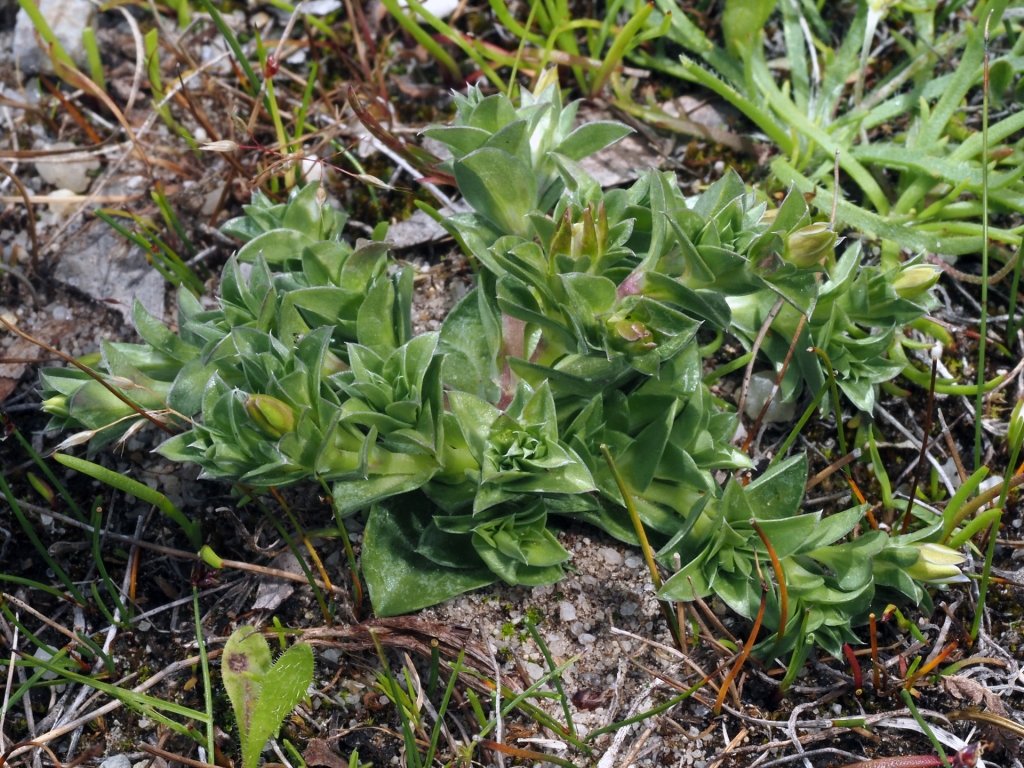Gentiana baeuerlenii
L.G.AdamsDescription: Annual (or biennial) herb with slender taproot. Stem erect, usually branching from base, minutely scabrous along most of the length but smooth below, 2–5 cm high. Rosette leaves persistent at flowering (2–) 3–5 pairs, sessile, broad-ovate, 7–20 mm long, 7–15 mm wide, mid green, acute, mucronate; mucro 0.3–0.5 mm long, hyaline. Cauline leaves 3–5 pairs, similar to rosette leaves but smaller, 4–8 mm long, 3.5–5 mm wide. Flowers 3–6 per stem or plant (when unbranched); pedicels ca. 1.5 mm long. Flowers (4-) 5-merous. Calyx narrow, infundibuliform. Sepals ovate, 1.5–3.3 mm long, acute, dorsally keeled; margins thickened, minutely scabrous, hyaline. Corolla narrow campanulate 5–7 mm long. Petals 4.5–5 mm long, acute, rotate in bud, spreading at anthesis, yellowish green towards base on the inside, the lobes white to light blue (particularly when in bud) with brownish-purple streaks on the inside and green on the outside. Plicae with the apices lacerate or irregularly 1–3 toothed, white to light blue. Anthers: pre-dehiscence 1.2–1.3 mm long, pale yellow with a pinkish tip; post-dehiscence 0.7–0.8 mm and pink post-dehiscence. Ovary shortly stipitate, compressed, narrowly winged along sutures. Gynophore elongating in fruit. Capsule ovoid, 2-valved. Seeds numerous, obliquely ellipsoid-fusiform, 0.4–0.6 mm long, reticulate-striolate, light brown. Flowers from late Nov.-Dec. (in Victoria)
WPro. Also ACT, NSW. In Victoria, known from a single recent (2023) collection from Wilsons Promontory. The plants at Wilsons Promontory are confined to a seasonally damp site on granitic sandy loam soil, associated with native and introduced forbs and graminoids.
Preliminary DNA sequencing (unpublished) clearly places the plants from Wilsons Promontory together with Gentiana baeuerlenii and G. bredboensis. There appear to be no clear key morphological differences that reliably distinguish these two species, with overlap in all characters. For example, anther length is used as one of the characters to distinguish the two species, with the anthers ca. 0.5 mm long in G. baeuerlenii and c. 1 mm long in G. bredboensis. However, post-dehiscence anther length varies from 0.5 to 0.8 mm in the holotype of Gentiana baeuerlenii. The other discriminatory characters appear to be rather plastic and some are likely to be under environmental influence. DNA sequences also show negligible difference between these two species. Gentiana baeuerlenii is here broadly circumscribed to include Gentiana bredboensis. The two names were introduced in the same work, with neither having priority. Wilhelm Baeuerlen made the earliest collection of an Australian Gentiana in 1887, and sent it to Mueller for identification. In recogntion of Baeuerlen's collection, the name Gentiana baeuerlenii is here adopted over G. bredboensis. This avoids the misleading association of a broadly distributed species with a single locality of Bredbo (southern NSW).
Gentiana baeuerlenii is listed as Endangered under the EPBC Act.
 Spinning
Spinning